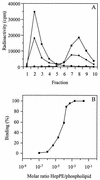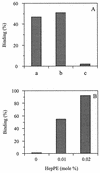Adaptation of alphaviruses to heparan sulfate: interaction of Sindbis and Semliki forest viruses with liposomes containing lipid-conjugated heparin
- PMID: 12239287
- PMCID: PMC136541
- DOI: 10.1128/jvi.76.20.10128-10137.2002
Adaptation of alphaviruses to heparan sulfate: interaction of Sindbis and Semliki forest viruses with liposomes containing lipid-conjugated heparin
Abstract
Passage of Sindbis virus (SIN) in BHK-21 cells has been shown to select for virus mutants with high affinity for the glycosaminoglycan heparan sulfate (HS). Three loci in the viral spike protein E2 (E2:1, E2:70, and E2:114) have been identified that mutate during adaptation and independently confer on the virus the ability to bind to cell surface HS (W. B. Klimstra, K. D. Ryman, and R. E. Johnston, J. Virol. 72:7357-7366, 1998). In this study, we used HS-adapted SIN mutants to evaluate a new model system involving target liposomes containing lipid-conjugated heparin (HepPE) as an HS receptor analog for the virus. HS-adapted SIN, but not nonadapted wild-type SIN TR339, interacted efficiently with HepPE-containing liposomes at neutral pH. Binding was competitively inhibited by soluble heparin. Despite the efficient binding of HS-adapted SIN to HepPE-containing liposomes at neutral pH, there was no fusion under these conditions. Fusion did occur, however, at low pH, consistent with cellular entry of the virus via acidic endosomes. At low pH, wild-type or HS-adapted SIN underwent fusion with liposomes with or without HepPE with similar kinetics, suggesting that interaction with the HS receptor analog at neutral pH has little influence on subsequent fusion of SIN at low pH. Finally, Semliki Forest virus (SFV), passaged frequently on BHK-21 cells, also interacted efficiently with HepPE-containing liposomes, indicating that SFV, like other alphaviruses, readily adapts to cell surface HS. In conclusion, the liposomal model system presented in this paper may serve as a novel tool for the study of receptor interactions and membrane fusion properties of HS-interacting enveloped viruses.
Figures









Similar articles
-
Antiviral activity of human lactoferrin: inhibition of alphavirus interaction with heparan sulfate.Virology. 2005 Mar 15;333(2):284-92. doi: 10.1016/j.virol.2005.01.010. Virology. 2005. PMID: 15721362
-
Adaptation of Sindbis virus to BHK cells selects for use of heparan sulfate as an attachment receptor.J Virol. 1998 Sep;72(9):7357-66. doi: 10.1128/JVI.72.9.7357-7366.1998. J Virol. 1998. PMID: 9696832 Free PMC article.
-
The furin protease cleavage recognition sequence of Sindbis virus PE2 can mediate virion attachment to cell surface heparan sulfate.J Virol. 1999 Aug;73(8):6299-306. doi: 10.1128/JVI.73.8.6299-6306.1999. J Virol. 1999. PMID: 10400721 Free PMC article.
-
The SARS-CoV-2 Entry Inhibition Mechanisms of Serine Protease Inhibitors, OM-85, Heparin and Soluble HS Might Be Linked to HS Attachment Sites.Molecules. 2022 Mar 17;27(6):1947. doi: 10.3390/molecules27061947. Molecules. 2022. PMID: 35335311 Free PMC article. Review.
-
Heparan sulfate: anchor for viral intruders?Biochimie. 2001 Aug;83(8):811-7. doi: 10.1016/s0300-9084(01)01290-1. Biochimie. 2001. PMID: 11530214 Review.
Cited by
-
Broad-spectrum agents for flaviviral infections: dengue, Zika and beyond.Nat Rev Drug Discov. 2017 Aug;16(8):565-586. doi: 10.1038/nrd.2017.33. Epub 2017 May 5. Nat Rev Drug Discov. 2017. PMID: 28473729 Free PMC article. Review.
-
Glycosaminoglycan binding by arboviruses: a cautionary tale.J Gen Virol. 2022 Feb;103(2):001726. doi: 10.1099/jgv.0.001726. J Gen Virol. 2022. PMID: 35191823 Free PMC article. Review.
-
Mutations in VP1 and 3A proteins improve binding and replication of rhinovirus C15 in HeLa-E8 cells.Virology. 2016 Dec;499:350-360. doi: 10.1016/j.virol.2016.09.025. Epub 2016 Oct 13. Virology. 2016. PMID: 27743961 Free PMC article.
-
The Structural Biology of Eastern Equine Encephalitis Virus, an Emerging Viral Threat.Pathogens. 2021 Jul 31;10(8):973. doi: 10.3390/pathogens10080973. Pathogens. 2021. PMID: 34451437 Free PMC article. Review.
-
Pathogens that infect mammalian cells via sulfonated glycosaminoglycans.Front Cell Infect Microbiol. 2025 Jun 10;15:1613923. doi: 10.3389/fcimb.2025.1613923. eCollection 2025. Front Cell Infect Microbiol. 2025. PMID: 40557318 Free PMC article. Review.
References
-
- Bernard, K. A., W. B. Klimstra, and R. E. Johnston. 2000. Mutations in the E2 glycoprotein of Venezuelan equine encephalitis virus confer heparan sulfate interaction, low morbidity, and rapid clearance from blood of mice. Virology 276:93-103. - PubMed
-
- Bernfield, M., M. Götte, P. W. Park, O. Reizes, M. L. Fitzgerald, J. Lincecum, and M. Zako. 1999. Functions of cell surface heparan sulfate proteoglycans. Annu. Rev. Biochem. 68:729-777. - PubMed
-
- Böttcher, C. J. F., C. M. van Gent, and C. Fries. 1961. A rapid and sensitive sub-micro phosphorus determination. Anal. Chim. Acta 24:203-204.
Publication types
MeSH terms
Substances
Grants and funding
LinkOut - more resources
Full Text Sources
Other Literature Sources
Medical

